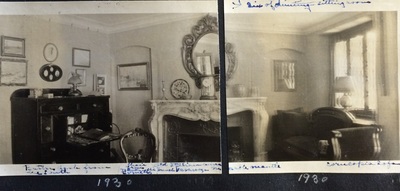
Marcham Hall or Village Hall
Formerly "The Stone House" or "Stonecroft"
836 Hanshaw Road
Year Completed: 1928
Full House History: Bea Szekely, "The Story of Marcham Hall"
For forty years before it became the municipal building of the Village of Cayuga Heights, Marcham Hall at 836 Hanshaw Road was a private residence. It was built in the late 1920s by Dorothy Cornell, the youngest granddaughter of Ezra Cornell. Dorothy's sister and brother-in-law, Eunice C. and Charles Taylor, lived next door at 830 Hanshaw Road.
Complete with a slate roof, a chandelier or two from the Hotel Martinique (a hotel the Taylors had run in New York City), a picket fence imported from France, fine ironwork hinges and handles on the doors and windows, a greenhouse, and a charming sundial on the outside wall, Stonecroft was Dorothy's dream house.
Formerly "The Stone House" or "Stonecroft"
836 Hanshaw Road
Year Completed: 1928
Full House History: Bea Szekely, "The Story of Marcham Hall"
For forty years before it became the municipal building of the Village of Cayuga Heights, Marcham Hall at 836 Hanshaw Road was a private residence. It was built in the late 1920s by Dorothy Cornell, the youngest granddaughter of Ezra Cornell. Dorothy's sister and brother-in-law, Eunice C. and Charles Taylor, lived next door at 830 Hanshaw Road.
Complete with a slate roof, a chandelier or two from the Hotel Martinique (a hotel the Taylors had run in New York City), a picket fence imported from France, fine ironwork hinges and handles on the doors and windows, a greenhouse, and a charming sundial on the outside wall, Stonecroft was Dorothy's dream house.
Interior Views of Stonecroft
Dorothy kept detailed scrapbooks documenting the construction of Stonecroft and later its interior furnishings, which she constantly refreshed by repositioning paintings, furniture, and other decorative items.
Click on the thumbnail images below to tour the interior of Dorothy Cornell's Stonecroft.
Click on the thumbnail images below to tour the interior of Dorothy Cornell's Stonecroft.
Dorothy Cornell's photographs of Stonecroft courtesy of The History Center of Tompkins County
Stonecroft Becomes the Village Hall
|
Dorothy lived in the home until the early 1940s. A succession of owners of the Stone House followed after World War II. In the late 1960s commercial development in the Community Corners area made the location ideal to acquire as the village hall, and it has been the signature landmark of Cayuga Heights since. In 1969 the Village purchased the house from the adjacent Village Green Shopping Center, naming it after Cornell Professor and former Village mayor, Frederick Marcham (see 112 Oak Hill Road), who served from 1956 to 1987.
|
Marcham Hall Highlights
1926 Dorothy Cornell, a granddaughter of Ezra Cornell, who founded Cornell University, is given the land by her sister and brother-in-law, Eunice C. and Charles Taylor, who live next door in the farmhouse that we know today as Warren Real Estate.
1927-1928 Dorothy Cornell oversees construction of the house villagers call “the Stone House,” complete with a slate roof, a chandelier or two from a hotel the Taylors had run in New York City, a picket fence imported from France, fine ironwork hinges and handles on the doors and windows, a greenhouse, and a charming sun dial on the outside wall.
1937 Having lost her money in the Depression, Dorothy Cornell sells the house to Franklin Cornell III and moves next door with her sister.
1950 Franklin’s widow Emily sells the building, and it changes owners several times in the two decades that follow.
1969 The Village of Cayuga Heights purchases the house from the Village Green Shopping Center, Inc. Monthly Board of Trustees meetings have been held there ever since in the former studio, which also becomes the Village courtroom. The former upstairs bedrooms provide offices for the mayor, superintendent of public works, and the village clerks. With modest renovation, the police department moves in downstairs in space at the side of the building. The greenhouse is maintained.
November 10, 1969 The first Board meeting is held in the courtroom, where a series of historic reproduction maps hang on the walls.
2012 A long-talked-about renovation is undertaken, partially with grant funding; changes include: a new jury room, a handicap accessible rear entrance and restrooms, an office for the Chief of Police, and more.
By Beatrice Szekely, Village Historian, [email protected]
1927-1928 Dorothy Cornell oversees construction of the house villagers call “the Stone House,” complete with a slate roof, a chandelier or two from a hotel the Taylors had run in New York City, a picket fence imported from France, fine ironwork hinges and handles on the doors and windows, a greenhouse, and a charming sun dial on the outside wall.
1937 Having lost her money in the Depression, Dorothy Cornell sells the house to Franklin Cornell III and moves next door with her sister.
1950 Franklin’s widow Emily sells the building, and it changes owners several times in the two decades that follow.
1969 The Village of Cayuga Heights purchases the house from the Village Green Shopping Center, Inc. Monthly Board of Trustees meetings have been held there ever since in the former studio, which also becomes the Village courtroom. The former upstairs bedrooms provide offices for the mayor, superintendent of public works, and the village clerks. With modest renovation, the police department moves in downstairs in space at the side of the building. The greenhouse is maintained.
November 10, 1969 The first Board meeting is held in the courtroom, where a series of historic reproduction maps hang on the walls.
2012 A long-talked-about renovation is undertaken, partially with grant funding; changes include: a new jury room, a handicap accessible rear entrance and restrooms, an office for the Chief of Police, and more.
By Beatrice Szekely, Village Historian, [email protected]










